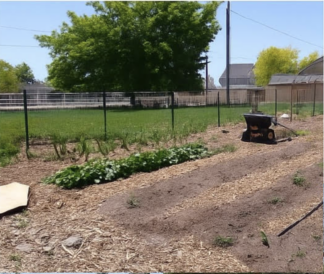Garden Help Desk: It’s time to take action to protect stone fruit trees
- Borer larvae at the base of a tree trunk can sometimes be exposed and removed by pulling back the soil against the trunk.
- Grass and other vegetation near the trunk provides the perfect egg-laying conditions for greater peachtree borers. Keep all vegetation at least 1 to 2 feet away from the trunk. This will also reduce the risk of mower and string trimmer damage.

Courtesy Meredith Seaver, USU Extension
Borer larvae at the base of a tree trunk can sometimes be exposed and removed by pulling back the soil against the trunk.
Greater peachtree borer season has arrived!
Now that we’re well into in the first half of June, it’s time to plan the protection our stone fruit trees (peaches, apricots, cherries and plums) will need to prevent damage from the greater peachtree borer (GPB). This borer is the moth that causes the gummy oozing seen at the soil line against the trunk and sometimes on the lowest part of the tree trunk.
Female moths lay eggs in bark crevices and the creamy white larvae bore into the lower trunk as soon as they hatch and feed on the cambium under the bark of the lower trunk and surface roots. They feed for the rest of the summer, overwinter in the tree and resume feeding in the spring, causing further damage to the tree.
These borers pupate in the tree and emerge as adults in late spring and early summer. It’s unlikely you would see one of the adults on your tree, but if you did, it would look more like a wasp than a moth.
If a tree is young and small, GPB feeding can easily girdle and kill it. Larger, more established trees may have reduced fruit production and reduced vigor. All of the damaging borer activity happens under the protective covering of the bark, out of reach of insecticidal sprays and other control efforts, so prevention is the most important thing you can do.

Courtesy Meredith Seaver, USU Extension
Grass and other vegetation near the trunk provides the perfect egg-laying conditions for greater peachtree borers. Keep all vegetation at least 1 to 2 feet away from the trunk. This will also reduce the risk of mower and string trimmer damage.
In the past, protective insecticidal sprays were applied to tree trunks at the beginning of July and again at the beginning of August, but that doesn’t provide adequate protection for stone fruit trees anymore. Insect development is influenced by temperature: the warmer the weather, the faster insects develop. As much of our solid zone 5 valley has warmed into a milder zone, we’ve seen the GPB showing up earlier. This means we need to do the first preventive application in mid-June if we want to protect our trees from this borer. June 15-20 is the recommended time for the first application this year.
Your spray application should protect the lower 12 inches of the trunk for your stone fruit trees. There is no need to spray the rest of the tree. Ornamental relatives of stone fruits can also be damaged by the GPB and may need protective insecticide applications. Flowering almond, weeping cherry and flowering plum trees are good examples of these ornamental trees.
Make sure the spray covers the entire lower surface area of all your stone fruit trunks, particularly close to ground level, including any exposed roots. Greater peachtree borer egg laying will continue all summer, so your protective sprays also need to continue until mid-September.
Not every insecticide is effective at preventing greater peachtree borer problems. Choose an effective spray product for your trees. Products with the active ingredient permethrin will provide reliable protection and only need to be applied once a month. Organic gardeners can look for products with the active ingredient pyrethrin or spinosad instead. These products must be applied every 10 days, though.
You can often stop some active borer feeding by pulling back the soil where you see oozing. This may expose borer larvae feeding at or just below the soil line. These larvae can be easily removed.
You may have heard that planting garlic around your trees, spreading moth balls around the trunk or painting the trunk with light-colored paint will stop greater peachtree borers. Research hasn’t shown garlic to be a reliable option and sprinkling mothballs or moth crystals around the base of the trunk is unsafe. Painting tree trunks with diluted white paint is one way to prevent Southwest winter injury but it doesn’t discourage borers.
Insecticides shouldn’t be your only tool in keeping GPBs out of your stone fruit trees. The same good tree care habits that give you a flavorful, bountiful harvest can also make your tree less attractive and more resistant to the greater peachtree borer.
Female borers prefer shaded, secluded areas for egg laying. Make your trees less attractive to female GPBs by keeping the area around your tree trunks free of weeds, grass and any other vegetation, and avoid adding excess soil around the base of the tree. The increased warmth, brighter light and drier conditions created by doing this will reduce the survival of eggs and larvae.
Protect the trunks of your trees. Prevent Southwest winter injury, avoid mechanical bark damage and prevent rodent-caused injuries to tree trunks.
Don’t leave protective tree wrap on the trunks during the summer.
Keep your trees healthy with optimal nutrition and irrigation. Apply adequate (but not excessive) nitrogen in the early spring. Water your trees deeply and infrequently, ideally not more than once a week during the summer and less often in the spring and fall, to encourage healthy, vigorous root systems.




